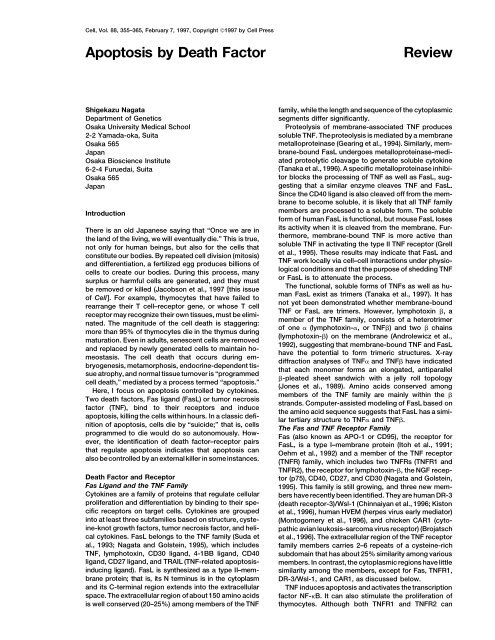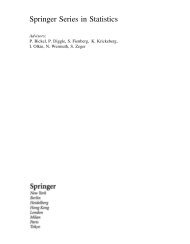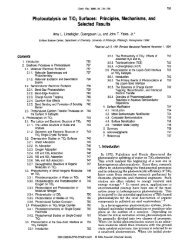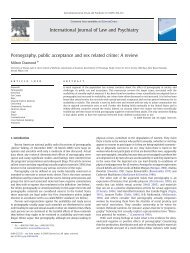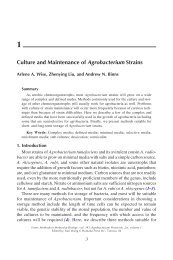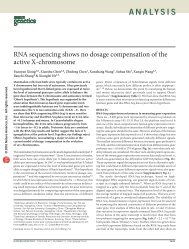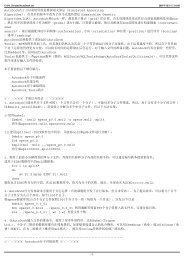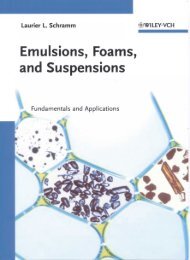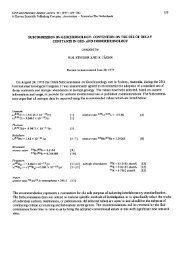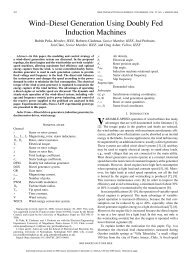Create successful ePaper yourself
Turn your PDF publications into a flip-book with our unique Google optimized e-Paper software.
Cell, Vol. 88, 355–365, February 7, 1997, Copyright ©1997 <strong>by</strong> Cell Press<br />
<strong>Apoptosis</strong> <strong>by</strong> <strong>Death</strong> <strong>Factor</strong> <strong>Review</strong><br />
Shigekazu Nagata family, while the length and sequence of the cytoplasmic<br />
Department of Genetics<br />
segments differ significantly.<br />
Osaka University Medical School<br />
Proteolysis of membrane-associated TNF produces<br />
2-2 Yamada-oka, Suita<br />
soluble TNF. Theproteolysis is mediated <strong>by</strong> a membrane<br />
Osaka 565<br />
metalloproteinase (Gearing et al., 1994). Similarly, mem-<br />
Japan<br />
brane-bound FasL undergoes metalloproteinase-medi-<br />
Osaka Bioscience Institute<br />
ated proteolytic cleavage to generate soluble cytokine<br />
6-2-4 Furuedai, Suita<br />
(Tanaka et al., 1996). A specific metalloproteinase inhibi-<br />
Osaka 565<br />
tor blocks the processing of TNF as well as FasL, sug-<br />
Japan<br />
gesting that a similar enzyme cleaves TNF and FasL.<br />
Since the CD40 ligand is also cleaved off from the membrane<br />
to become soluble, it is likely that all TNF family<br />
Introduction<br />
members are processed to a soluble form. The soluble<br />
form of human FasL is functional, but mouse FasL loses<br />
There is an old Japanese saying that “Once we are in<br />
the land of the living, we will eventually die.” This is true,<br />
not only for human beings, but also for the cells that<br />
constitute our bodies. By repeated cell division (mitosis)<br />
and differentiation, a fertilized egg produces billions of<br />
cells to create our bodies. During this process, many<br />
surplus or harmful cells are generated, and they must<br />
be removed or killed (Jacobson et al., 1997 [this issue<br />
of Cell]. For example, thymocytes that have failed to<br />
rearrange their T cell–receptor gene, or whose T cell<br />
receptor may recognize their own tissues, must be elimi-<br />
nated. The magnitude of the cell death is staggering:<br />
more than 95% of thymocytes die in the thymus during<br />
maturation. Even in adults, senescent cells are removed<br />
and replaced <strong>by</strong> newly generated cells to maintain ho-<br />
meostasis. The cell death that occurs during em-<br />
bryogenesis, metamorphosis, endocrine-dependent tis-<br />
sue atrophy, and normal tissue turnover is “programmed<br />
cell death,” mediated <strong>by</strong> a process termed “apoptosis.”<br />
Here, I focus on apoptosis controlled <strong>by</strong> cytokines.<br />
Two death factors, Fas ligand (FasL) or tumor necrosis<br />
factor (TNF), bind to their receptors and induce<br />
apoptosis, killing the cells within hours. In a classic defi-<br />
nition of apoptosis, cells die <strong>by</strong> “suicide;” that is, cells<br />
programmed to die would do so autonomously. However,<br />
the identification of death factor–receptor pairs<br />
that regulate apoptosis indicates that apoptosis can<br />
also be controlled <strong>by</strong> an external killer in someinstances.<br />
its activity when it is cleaved from the membrane. Furthermore,<br />
membrane-bound TNF is more active than<br />
soluble TNF in activating the type II TNF receptor (Grell<br />
et al., 1995). These results may indicate that FasL and<br />
TNF work locally via cell–cell interactions under physio-<br />
logical conditions and that the purpose of shedding TNF<br />
or FasL is to attenuate the process.<br />
The functional, soluble forms of TNFs as well as hu-<br />
man FasL exist as trimers (Tanaka et al., 1997). It has<br />
not yet been demonstrated whether membrane-bound<br />
TNF or FasL are trimers. However, lymphotoxin �, a<br />
member of the TNF family, consists of a heterotrimer<br />
of one � (lymphotoxin-�, or TNF�) and two � chains<br />
(lymphotoxin-�) on the membrane (Androlewicz et al.,<br />
1992), suggesting that membrane-bound TNF and FasL<br />
have the potential to form trimeric structures. X-ray<br />
diffraction analyses of TNF� and TNF� have indicated<br />
that each monomer forms an elongated, antiparallel<br />
�-pleated sheet sandwich with a jelly roll topology<br />
(Jones et al., 1989). Amino acids conserved among<br />
members of the TNF family are mainly within the �<br />
strands. Computer-assisted modeling of FasL based on<br />
the amino acid sequence suggests that FasL has a similar<br />
tertiary structure to TNF� and TNF�.<br />
The Fas and TNF Receptor Family<br />
Fas (also known as APO-1 or CD95), the receptor for<br />
FasL, is a type I–membrane protein (Itoh et al., 1991;<br />
Oehm et al., 1992) and a member of the TNF receptor<br />
(TNFR) family, which includes two TNFRs (TNFR1 and<br />
TNFR2), the receptor for lymphotoxin-�, the NGF recep-<br />
<strong>Death</strong> <strong>Factor</strong> and Receptor tor (p75), CD40, CD27, and CD30 (Nagata and Golstein,<br />
Fas Ligand and the TNF Family 1995). This family is still growing, and three new mem-<br />
Cytokines are a family of proteins that regulate cellular bers have recently been identified. They are human DR-3<br />
proliferation and differentiation <strong>by</strong> binding to their spe- (death receptor-3)/Wsl-1 (Chinnaiyan et al., 1996; Kiston<br />
cific receptors on target cells. Cytokines are grouped et al., 1996), human HVEM (herpes virus early mediator)<br />
into at least three subfamilies based on structure, cyste- (Montogomery et al., 1996), and chicken CAR1 (cytoine-knot<br />
growth factors, tumor necrosis factor, and heli- pathic avian leukosis-sarcoma virus receptor) (Brojatsch<br />
cal cytokines. FasL belongs to the TNF family (Suda et et al., 1996). The extracellular region of the TNF receptor<br />
al., 1993; Nagata and Golstein, 1995), which includes family members carries 2–6 repeats of a cysteine-rich<br />
TNF, lymphotoxin, CD30 ligand, 4-1BB ligand, CD40 subdomain that has about 25% similarity among various<br />
ligand, CD27 ligand, and TRAIL (TNF-related apoptosis- members. In contrast, the cytoplasmic regions have little<br />
inducing ligand). FasL is synthesized as a type II–mem- similarity among the members, except for Fas, TNFR1,<br />
brane protein; that is, its N terminus is in the cytoplasm DR-3/Wsl-1, and CAR1, as discussed below.<br />
and its C-terminal region extends into the extracellular TNF induces apoptosis and activates the transcription<br />
space. The extracellular region of about 150 amino acids factor NF-�B. It can also stimulate the proliferation of<br />
is well conserved (20–25%) among members of the TNF<br />
thymocytes. Although both TNFR1 and TNFR2 can
Cell<br />
356<br />
transduce the signal for apoptosis and NF-�B activation, Fas- and TNFR1-mediated apoptosis occur in the<br />
TNFR1 is responsible for these signals in most cases presence of inhibitors of either RNA or protein synthesis<br />
(Vandenabeele et al., 1995). On the other hand, TNFR2 (Yonehara et al., 1989; Itoh et al., 1991). Even enucleated<br />
but not TNFR1 is responsible for the TNF-induced prolif- cells undergo apoptosis upon Fas activation (Schulzeeration<br />
signal in thymocytes. Binding of FasL to Fas or Osthoff et al., 1994), suggesting that all of the compocross-linking<br />
Fas with agonistic antibodies (IgM class nents necessary for apoptotic signal transduction are<br />
anti-Fas antibody, or IgG3 class anti-APO1 antibody) present and that Fas activation simply triggers this mainduces<br />
apoptosis in Fas-bearing cells (Trauth et al., chinery. To dissect the signal-transducing machinery for<br />
1989; Yonehara et al., 1989; Itoh et al., 1991). Most other Fas- and TNFR1-mediated apoptosis, two approaches<br />
receptors in the TNF receptor family transduce activa- have been used. In one approach, several groups have<br />
tion or stimulatory signals, although some of them, such identified a molecule(s) that binds to the cytoplasmic<br />
as CD40 and CD30, may also have the ability to inhibit region of Fas or TNFR1, while in the other, information<br />
growth, probably causing apoptosis. The presence of<br />
a homologous domain (about 80 amino acids) in the<br />
cytoplasmic regions of Fas and TNFR1 suggested that<br />
this region is responsible for transducing the death signal.<br />
In fact, subsequent mutational analyses in Fas and<br />
TNFR1 indicated that this is the case, and this domain<br />
has been designated a death domain (Itoh and Nagata,<br />
1993; Tartaglia et al., 1993). DR-3/Wsl-1 also carries a<br />
death domain and has the potential to transduce an<br />
apoptotic signal, as well as to activate NF-�B (Chinnai-<br />
yan et al., 1996; Kiston et al., 1996). CAR1, which also<br />
contains a death domain, has been shown to cause<br />
apoptosis in chicken cells when it is cross-linked <strong>by</strong> the<br />
envelope protein of ALSV (Brojatsch et al., 1996).<br />
The death domain has a tendency to self-aggregate,<br />
and the tertiary structure of the Fas death domain, revealed<br />
<strong>by</strong> heteronuclear multidimensional NMR spec-<br />
troscopy, shows that the death domain is a novel protein<br />
fold consisting of six antiparallel, amphipathic � helices<br />
(Huang et al., 1996). Many charged amino acids are<br />
present on the surface, which is probably responsible<br />
for mediating the interactions between death domains<br />
described below.<br />
gained from studying apoptosis in the nematode, C.<br />
elegans, was applied to the Fas and TNF system.<br />
Utilization of the yeast two-hybrid system with the Fas<br />
cytoplasmic region as bait led to the identification of<br />
a molecule called FADD (Fas-associating protein with<br />
death domain) or MORT1, which contains a death do-<br />
main at its C terminus (Boldin et al., 1995; Chinnaiyan<br />
et al., 1995). FADD/MORT1 is recruited to Fas upon its<br />
activation (Kischkel et al., 1995) and binds to Fas via<br />
interactions between the death domains. The N-terminal<br />
region (termed the death effector domain [DED] or<br />
MORT1 domain) is responsible for downstream signal<br />
transduction. A similar death domain–containing protein<br />
(TRADD, TNFR1-associated death domain protein)<br />
binds to TNFR1 (Hsu et al., 1995). But unlike FADD/<br />
MORT1, TRADD does not carry a death effector domain,<br />
and its death domain is responsible for mediating<br />
apoptosis. This apparent discrepancy between FADD/<br />
MORT1 and TRADD is resolved <strong>by</strong> the finding that<br />
TRADD binds to FADD/MORT1 via interactions between<br />
their death domains (Hsu et al., 1996b). These results<br />
suggest that Fas and TNFR1 use FADD as a common<br />
signal transducer and share the signaling machinery<br />
Signal for <strong>Apoptosis</strong><br />
Cascade Leading to ICE<br />
Binding of ligand to a tyrosine kinase receptor, such<br />
as PDGF or EGF receptor, induces dimerization of the<br />
receptor and activates the intrinsic kinase activity in the<br />
cytoplasmic domain. The receptors for hematopoietic<br />
growth factors such as colony-stimulating factor and<br />
for interferons do not contain kinase domains in their<br />
cytoplasmic regions. Instead, the ligand-induced dimer-<br />
ization recruits a kinase(s) to the receptor and activates<br />
it, which then results in transduction of the proliferation<br />
downstream of FADD/MORT1 (Figure 1). In addition to<br />
this pathway, TNFR1 has another pathway leading to<br />
apoptosis. RIP (receptor interacting protein), originally<br />
identified as a Fas-binding protein, preferentially binds<br />
to TRADD (Hsu et al., 1996a). RIP is a serine/threonine<br />
kinase containing a death domain and binds to TRADD<br />
via interactions between their death domains. RIP in-<br />
duces apoptosis when overexpressed. The death do-<br />
main of RIP, but not its kinase domain, is responsible<br />
for transduction of the death signal, indicating that RIP<br />
does not possess a death effector domain, but rather<br />
and/or differentiation signals. In the case of Fas or another downstream effector molecule may be recruited<br />
TNFR1, however, dimerization with a divalent anti-Fas or through the death domain of RIP (see below) (Figure 1).<br />
TNFR1 monoclonal antibody is not sufficient to activate To find the signaling molecule downstream of FADD/<br />
these receptors. Fas and TNFR1 must be oligomerized MORT1, Wallach and his associates again used the<br />
to be activated; that is, IgM class anti-Fas monoclonal yeast two-hybrid system, using the N-terminal DED/<br />
antibody or IgG3 class anti-APO1 antibody that possess MORT1 domain of FADD/MORT1 as bait (Boldin et al.,<br />
a tendency to aggregate function as potent agonists 1996). At the same time, a collaborative group, led <strong>by</strong><br />
(Trauth et al., 1989; Yonehara et al., 1989). X-ray diffrac- Dixit and Peter, continued the biochemical characterization<br />
analysis of the TNF�–TNF receptor complex has tion of molecules recruited to the activated Fas receptor<br />
indicated that a TNF� trimer makes a complex with three (Muzio et al., 1996). Both groups identified the same<br />
molecules of the extracellular region of the TNF receptor molecule, which was originally termed FLICE (FADD-<br />
(Banner et al., 1993), suggesting that TNF induces tri- like ICE) or MACH (MORT1-associated CED-3 homomerization<br />
of the receptor. The similarity between the logue) and is now designated caspase-8 (Alnemri et<br />
structures of FasL and TNF and between Fas and the al., 1996) (Table 1). Caspase-8 carries two DED/MORT1<br />
TNF receptors suggests that FasL also induces trimeri- domains at the N-terminal region, through which it binds<br />
zation of Fas and that the trimerized cytoplasmic region FADD/MORT1. The C-terminal region of caspase-8 is<br />
then transduces the signal. related to ICE family members, more specifically, to
<strong>Review</strong>: <strong>Apoptosis</strong> <strong>by</strong> <strong>Death</strong> <strong>Factor</strong><br />
357<br />
Figure 1. Models for <strong>Apoptosis</strong> Signaling <strong>by</strong> <strong>Death</strong> <strong>Factor</strong>s<br />
(A) Fas-induced apoptosis. Binding of FasL to Fas induces trimerization of the Fas receptor, which recruits caspase-8 (FLICE/MACH) via an<br />
adaptor, FADD/MORT1. The oligomerization of FLICE may result in self-activation of proteolytic activity and trigger the ICE protease cascade.<br />
The activated ICE members can cleave various substrates, such as poly(ADP) ribose polymerase (PARP), lamin, rho-GDI, and actin, and cause<br />
morphological changes to the cells and nuclei.<br />
(B) TNF-induced apoptosis. TNF binds to TNFR1, and the trimerized receptor recruits TRADD via interactions between death domains. The<br />
death domain of TRADD then recruits FADD/MORT1 in one pathway to activate caspase-8. In another pathway, RIP binds to TRADD and<br />
transduces an apoptotic signal through the death domain. In addition, RIP together with TRAF2 activates NF-�B, which may induce the<br />
expression of survival genes. The role of the kinase activity of RIP is currently unknown.<br />
members of the caspase-3 (CPP32) subfamily, and re- self-activation of the protease domain. One apoptotic<br />
combinant caspase-8 preferentially cleaves caspase-3 pathway from TNFR1 uses caspase-8 pathway through<br />
substrates over caspase-1 (ICE) substrates (Boldin et the interaction of TRADD with FADD/MORT1. TRADD<br />
al., 1996).<br />
additionally recruits RIP, which may trigger a second<br />
Figure 1 presents the current model for Fas- and apoptotic pathway. The recently identified DR-3/Wsl-1<br />
TNFR1-mediated apoptosis. Binding of a trimeric FasL receptor is more similar to TNFR1 than to Fas. That is,<br />
to Fas induces trimerization of Fas, and FADD/MORT1 DR-3 binds TRADD, which then recruits FADD and RIP<br />
binds to the trimerized Fas cytoplasmic region through (Chinnaiyan et al., 1996; Kiston et al., 1996). The apop-<br />
the interaction of the respective death domains. Cas- totic signaling pathway downstream of RIP is currently<br />
pase-8 is then recruited to FADD/MORT1 through bind- unknown. However, another death domain–containing<br />
ing of the DED domains, which in turn may induce adaptor, termed RAIDD (RIP-associated Ich-1/CED-3<br />
Table 1. Human ICE Protease Superfamily<br />
Recognition<br />
Proteases Alternative Names Sequence Substrates<br />
caspase-1 ICE YVAD pro-IL1�, pro-caspase 3 and 4<br />
caspase-4 ICErel-II, TX, ICH-2<br />
caspase-5 ICErel-III, TY<br />
caspase-2 ICH-1 PARP<br />
caspase-9 ICE-LAP6 PARP<br />
caspase-3 CPP32, Yama, apopain DEVD PARP, DNA-PK, SRE/BP, rho-GDI<br />
caspase-6 Mch2 VEID lamin A<br />
caspase-7 Mch3, ICE-LAP3, CMH-1 PARP, pro-caspase 6<br />
caspase-8 FLICE, MACH, Mch5<br />
caspase-9 ICE-LAP6, Mch6 PARP<br />
caspase-10 Mch4<br />
The caspase family members can be divided into three subfamilies: caspase-1 (ICE), caspase-2 (ICH-1), and caspase-3 (CPP32), according<br />
to Alnemiri et al. (1996).
Cell<br />
358<br />
homologous protein with a death domain) has recently designated as caspases (cysteine aspases) (Table 1)<br />
been identified (Duan and Dixit, 1997). RAIDD binds RIP (Alnemri et al., 1996). So far, recognition sequences for<br />
through its death domain and recruits caspase-2 (Ich-1) three ICE family members have been identified. That is,<br />
to RIP. Although an involvment of RAIDD in the TNFR1 caspase-1 (ICE) recognizes the sequence Tyr–Val–Ala–<br />
or DR3/Wsl-1-mediated apoptotic pathway has not yet Asp (YVAD) in the proform of IL-1�, caspase-3 (CPP32/<br />
been demonstrated, it is possible that RAIDD plays a Yama/apopain) recognizes Asp–Glu–Val-Asp (DEVD)<br />
role in transducing an apoptotic signal from one of the and cleaves poly(ADP-ribose) polymerase, and cas-<br />
death receptors.<br />
pase-6 (Mch2) recognizes Val–Glu–Ile–Asp (VEID) and<br />
The signal from Fas seems to be restricted to cleaves lamin (Nicholson et al., 1995; Takahashi et al.,<br />
apoptosis, whereas other members of the TNF receptor 1996). However, it is uncertain whether each ICE family<br />
family including TNFR1 activate NF-�B. NF-�B activa- member has a specific substrate for mediating apoption<br />
<strong>by</strong> TNF receptor family members is mediated <strong>by</strong> tosis, or if some members of the subfamily are redun-<br />
TRAF (TNF receptor–associated factor) family (Rothe et dant, cleaving the same substrates. In this regard, it is<br />
al., 1994). So far, five members have been identified in noteworthy that caspase-1-null mice do not show any<br />
this family, and all contain a TRAF domain of about 230 phenotype in programmed cell death (Li et al., 1995),<br />
amino acids. Among members of this family, TRAF2 while the mice lacking caspase-3 show hyperplasia and<br />
binds directly to TNFR2 and CD30 and indirectly to disorganized cell development in the brain (Kuida et al.,<br />
TNFR1 through TRADD and RIP. A dominant-negative 1996). These results suggest that caspase-1 is redun-<br />
TRAF2 blocks TNF-induced NF-�B activation, but not dant in all cell types, while caspase-3 plays a major role<br />
apoptosis (Liu et al., 1996). Instead, blocking NF-�B in apoptosis in some cells of the brain.<br />
activation with the dominant-negative TRAF2 potenti- Using what was known about the specific recognition<br />
ates the cytotoxic activity of TNF in various cell types, sequences of the ICE proteases, specific competitive<br />
suggesting that NF-�B activation leads to the expres- inhibitors and fluorescent substrates for caspase-1<br />
sion of a protein(s) that inhibits TNF-induced cytotoxic- and -3 have been designed (Thornberry et al., 1992). In<br />
ity. NF-�B consists of two subunits (p50 and p65) and addition, several proteins encoded <strong>by</strong> viral genes are<br />
exists in a complex with I�B in resting cells. The signal known to inhibit members of the ICE family. These in-<br />
from TRAF2 results in phosphorylation of I�B and subse- clude crmA, a cytokine response–modifier gene enquent<br />
degradation <strong>by</strong> the proteosome. NF-�B, thus recoded <strong>by</strong> cowpox virus, and p35, coded for <strong>by</strong> Baculovileased<br />
from I�B, enters the nucleus and activates vari- rus. These viral proteins seem to inhibit protease activity<br />
ous genes carrying the NF-�B response element. Cells <strong>by</strong> forming a stable complex. p35 has a broader specific-<br />
lacking one component of NF-�B (65 kDa) or expressing ity for ICE family members than crmA. That is, crmA<br />
I�B mutants that cannot be phosphorylated are more preferentially inhibits caspase-1 over caspase-3, while<br />
sensitive to TNF-induced cytotoxicity, confirming that p35 inhibits both caspase-1 and -3 equally well.<br />
one of the target genes for NF-�B is a gene encoding Inhibitors of caspase-1 or -3 block Fas- and TNF-<br />
a survival factor (Beg and Baltimore, 1996; Liu et al., induced apoptosis, which suggests that both cas-<br />
1996; Van Antwerp et al., 1996; Wang et al., 1996). These pase-1- and caspase-3-like proteases are involved in<br />
results are in good agreement with the fact that Fas, Fas- and TNFR1- mediated apoptosis (Enari et al.,<br />
which cannot activate NF-�B, mediates a stronger apop- 1995b; Los et al., 1995; Tewari and Dixit, 1995; Enari et<br />
totic signal than TNFR1, which can activate NF-�B. The al., 1996). Monitoring the protease activity with specific<br />
cytotoxicity of TNF can be potentiated <strong>by</strong> cycloheximide fluorescent substrates for caspase-1 and -3 demon-<br />
or actinomycin D, which is probably due to the inhibition strates that a caspase-1-like protease is transiently actiof<br />
the NF-�B-induced gene expression.<br />
vated, whereas the activation of a caspase-3-like prote-<br />
ICE Protease Cascade ase gradually increases during Fas-induced apoptosis<br />
Genetic analysis of programmed cell death in C. elegans (Enari et al., 1996). A similar sequential activation of<br />
has revealed a number of gene products that regulate caspase-1- and caspase-3-like proteases was also<br />
the cell death process (Ellis et al., 1991). Among them, found in vivo. When agonistic anti-Fas antibody was<br />
the CED-3 product is required for cell death, and molec- administered to mice, the livers were damaged (Ogaular<br />
cloning of the ced-3 gene revealed it to be a homosawara et al., 1993). As the damage proceeded, caslogue<br />
of mammalian ICE (interleukin-1� converting en- pase-1-like activity was detected in the liver, followed<br />
zyme) (Yuan et al., 1993), which converts the IL-1� <strong>by</strong> the gradual activation of a caspase-3-like protease<br />
precursor to the mature form. ICE is a cysteine protease (Rodriguez et al., 1996a). The activation of the caspaseconsisting<br />
of two large (p17) and two small (p10) sub- 3-like protease is dependent on the activation of a casunits,<br />
which are generated <strong>by</strong> proteolytic cleavage of pase-1-like protease (Enari et al., 1996), indicating that<br />
the ICE precursor (a zymogen). Cross-hybridization with these proteases are sequentially activated. This sequen-<br />
ICE cDNA and a search of the human genome database tial activation can also be seen in a cell-free system.<br />
revealed at least 10 ICE homologues (see Table 1), which That is, cell lysate from Fas-activated, but not from<br />
are divided into three subgroups (ICE-like, CPP32-like, nonactivated cells, induced apoptotic morphological<br />
and Ich1-like proteases), based on their sequence ho- changes in intact nuclei (Enari et al., 1995a). However,<br />
mology (Alnemri et al., 1996). All of these cause apop- when the cell lysates from growing, nonapoptotic cells<br />
tosis when overexpressed in cells. They appear to be were supplemented with recombinant caspase-1 or -3,<br />
cysteine proteases, containing conserved sequences the lysates induced apoptosis. This caspase-1-induced<br />
for substrate binding and catalysis; they cleave their apoptosis was inhibited, not only <strong>by</strong> an inhibitor of cas-<br />
substrates after aspartic acid. Therefore, they are now pase-1, but also <strong>by</strong> the inhibitor of caspase-3 (Enari et
<strong>Review</strong>: <strong>Apoptosis</strong> <strong>by</strong> <strong>Death</strong> <strong>Factor</strong><br />
359<br />
al., 1996), confirming the sequential activation of cas- However, little is known about the biochemical mechapase-1-<br />
and caspase-3-like proteases. It is likely that nism where<strong>by</strong> CED-9/Bcl-2 and their family members<br />
other members of the ICE family are also activated in inhibit apoptosis. Bcl-2 and Bcl-x are localized to outer<br />
the cascade, cleaving their “death substrates” such as mitochondrial membranes and endoplasmic reticulum<br />
lamin, actin, poly(ADP)ribose polymerase, rho-GDI, as well as nuclear membranes. The tertiary structure of<br />
SREBP, and DNA-dependent protein kinase, to cause Bcl-xL has been determined <strong>by</strong> X-ray and NMR analyses<br />
the apoptotic morphological changes observed on cells (Muchmore et al., 1996). It consists of two central, hyand<br />
nuclei, as well as chromosomal DNA degradation. drophobic � helices, which are similar to the pore-form-<br />
As discussed above, Fas engagement recruits cas- ing bacteria toxins such as diphtheria toxin and the<br />
pase-8 to the Fas receptor complex. How can this result colicins, suggesting that Bcl-xL also generates pores in<br />
be integrated into the model of sequential ICE protease the membrane. When mitochondria are damaged <strong>by</strong> an<br />
activation? Here, I suggest two models. In the first agent that causes permeability transition, nuclear apopmodel,<br />
the oligomerization of caspase-8 through the tosis is induced (Zamzami et al., 1996). This permeability<br />
interaction with FADD/MORT1 leads to its autocatalytic<br />
activation, which then triggers the protease cascade <strong>by</strong><br />
cleaving the caspase-1-like protease zymogen. In the<br />
second model, oligomerization does not activate caspase-8,<br />
but a caspase-1-like protease activates the<br />
oligomerized caspase-8, which then sequentially activates<br />
other members of the ICE family. In addition to<br />
ICE family proteases, other proteases such as cathepsin<br />
D aspartic protease and the serine protease AP24<br />
(apoptosis protease 24) may be involved in Fas- and<br />
TNFR1-induced apoptosis. To understand how these<br />
proteases may be involved in the apoptotic process,<br />
it will be necessary to biochemically characterize the<br />
purified or recombinant proteins and determine their<br />
specific substrates.<br />
The Bcl-2 Family<br />
ced-9, a homologue of the mammalian protooncogene<br />
Bcl-2, prevents programmed cell death in C. elegans<br />
(Hengartner and Horvitz, 1994). Similarly, overexpres-<br />
sion of Bcl-2 blocks apoptosis of mammalian cells that<br />
is triggered <strong>by</strong> a number of different stimuli such as<br />
factor deprivation, irradiation, c-myc, or anti-cancer<br />
drugs. A number of CED-9/Bcl-2 family members have<br />
been identified in mammals: Bcl-2, Bcl-xL, Bcl-w, and<br />
Mcl-1 inhibit apoptosis, whereas others, such as Bax,<br />
Bik, Bak, Bad, and Bcl-xs, activate apoptosis. The vari-<br />
ous Bcl-2 family members can dimerize with one an-<br />
other, with one monomer antagonizing or enhancing the<br />
function of the other. In this way, the ratio of inhibitors<br />
to activators in a cell may determine the propensity of<br />
the cell to undergo apoptosis (Yang and Korsmeyer,<br />
1996). For example, if either bcl-x (Motoyama et al.,<br />
1995) or bcl-2 (Veis et al., 1993) is disrupted in mice, the<br />
animals die as embryos or postnatally, respectively, as<br />
transition of mitochondrial membrane, and thus nuclear<br />
apoptosis, is blocked <strong>by</strong> Bcl-2, suggesting that the<br />
membrane pores in the mitochondria, generated <strong>by</strong><br />
the Bcl-2 family members, play an important role in<br />
apoptosis, at least in this system.<br />
Bcl-2 and Bcl-xL can also inhibit Fas-mediated apop-<br />
tosis in vitro as well as in vivo (Itoh et al., 1993; Boise<br />
et al., 1995; Rodriguez et al., 1996b). Fas activation damages<br />
mitochondrial function, but the damage is inhibited<br />
<strong>by</strong> ICE protease inhibitors (Krippner et al., 1996). These<br />
results suggest that the mitochondrial damage is down-<br />
stream of the ICE protease cascade in Fas-induced<br />
apoptosis and is probably a secondary effect. Thus, it<br />
is not clear how Bcl-2/Bcl-xL located in mitochondria<br />
can modulate the Fas-induced apoptotic signaling pathway<br />
that seems to take place in the cytoplasm. One<br />
possible mechanism is that the damage of mitochondria<br />
<strong>by</strong> ICE protease may amplify the signal <strong>by</strong> releasing<br />
apoptosis-inducing molecules (Krippner et al., 1996;<br />
Zamzami et al., 1996).<br />
Other Regulators in the Signaling Pathway<br />
Ceramide, generated <strong>by</strong> sphingomyelinases, increases<br />
during Fas- or TNFR1-mediated apoptosis, and cera-<br />
mide itself can induce cell death (Spiegel et al., 1996).<br />
Since ceramide activates the ras/MAP kinase pathway,<br />
it was postulated that activated ras is responsible for<br />
apoptotic cell death. However, the recent observation<br />
that generation of ceramide and activation of JNK during<br />
Fas activation is blocked <strong>by</strong> ICE protease inhibitors sug-<br />
gests that the production of ceramide occurs down-<br />
stream of the ICE protease cascade (Gamen et al., 1996;<br />
Lenczowski et al., 1997). An increase in ceramide during<br />
Fas activation is likely to be one of the changes that<br />
the result of excessive programmed cell death in partic- accompanies apoptosis and is unlikely to be a mediator<br />
ular organs. Conversely, if bax is disrupted, some normal of apoptosis. Many other proteins have been suggested<br />
programmed cell death fails to occur (Knudson et al., as regulators of Fas-mediated apoptosis. For example,<br />
1995). Another attractive mechanism to regulate dimer- c-abl tyrosine kinase, FAP tyrosine phosphatase, and<br />
ization of Bcl-2 family members is phosphorylation (Gasmall stress proteins (HSP24) inhibit the process,<br />
whereas the Fas-associated proteins of p59fyn jewski and Thompson, 1996). For example, Bad, a pro-<br />
kinase<br />
apoptotic member of the Bcl-2 family, is phosphorylated and FAF seem to augment apoptotic signal induced <strong>by</strong><br />
<strong>by</strong> a putative kinase that can be activated <strong>by</strong> growth Fas. How these proteins regulate the process is currently<br />
factor engagement. The phosphorylated Bad loses the<br />
ability to bind Bcl-xL. Instead, it binds to 14-3-3, a protein<br />
that can interact with several signaling enzymes.<br />
unknown.<br />
The Bcl-xL dissociated from Bad now can execute its Physiological and Pathological Roles of Fas<br />
antiapoptotic function (Zha et al., 1996).<br />
Down-Regulation of the Immune Reaction<br />
How does Bcl-2 or Bcl-xL inhibit apoptosis? Genetic <strong>Apoptosis</strong> occurs in various processes in mammalian<br />
studies of ced-9, ced-4, and ced-3 mutants in C. elegans life (Jacobson et al., 1997). What kinds of apoptosis<br />
indicate that ced-9 controls programmed cell death up- are regulated <strong>by</strong> the Fas system? Fas is ubiquitously<br />
stream of ced-4 and ced-3 (Shaham and Horvitz, 1996). expressed in various tissues with abundant expression
Cell<br />
360<br />
after the activated T cells accomplish their task, they<br />
must be removed to avoid accumulation. Mature T cells<br />
from lpr or gld mice do not die after activation, and<br />
activated cells accumulate in the lymph nodes and<br />
spleens of these mice. When T cell hybridomas are activated<br />
in the presence of a Fas-neutralizing molecule,<br />
they do not die. These results indicate that Fas is involved<br />
in activation-induced suicide of T cells, i.e., in<br />
down-regulation of the immune reaction (Figure 3A) (Nagata<br />
and Golstein, 1995). Peripheral clonal deletion may<br />
also be mediated <strong>by</strong> the Fas system, because the cells<br />
to be deleted in this process are activated <strong>by</strong> interactions<br />
with cells expressing self antigens. However, thymic<br />
clonal deletion is apparently normal in mice lacking<br />
the functional Fas system (lpr-, gld-, or Fas-null mice)<br />
(Singer and Abbas, 1994), even though thymocytes<br />
abundantly express Fas and are sensitive to Fasinduced<br />
apoptosis. These results suggest that Fas is<br />
not involved in the deletion process in the thymus, although<br />
one cannot rule out the possibility that this process<br />
is mediated <strong>by</strong> redundant mechanisms.<br />
In addition to T cells, the Fas-deficient mice accumulate<br />
B cells and have elevated levels of immunoglobulins<br />
Figure 2. When <strong>Apoptosis</strong> Fails<br />
of various classes that include anti-ssDNA and anti-<br />
Wild-type (�/�) and Fas-null (�/�) mice were killed at 16 weeks of<br />
age, and their lymph nodes (LN) and spleen (SP) are shown (from dsDNA antibodies (Cohen and Eisenberg, 1991), sug-<br />
Adachi et al., 1995).<br />
gesting an involvement of the Fas system in the deletion<br />
of activated or autoreactive B lymphocytes. In fact, immunization<br />
of mice with antigens rapidly induces Fas<br />
in the thymus, liver, heart, and kidney. On the other expression in germinal centers. Furthermore, the actihand,<br />
FasL is predominantly expressed in activated T vation of naive B cells through CD40 sensitizes them<br />
lymphocytes and Natural Killer (NK) cells, although it to Fas-mediated apoptosis, while their costimulation<br />
is also expressed constitutively in the tissues of the through CD40 and Ig receptor makes them resistant<br />
“immune-privilege sites” such as the testis and eye, as (Rothstein et al., 1995). Although these results suggest<br />
described below. The mouse mutations, lpr (lympho- that FasL-expressing T cells kill the Fas-expressing actiproliferation)<br />
and gld (generalized lymphoproliferative vated B cells, the precise mechanism and physiological<br />
disease), are spontaneous recessive mutations (Cohen role of Fas in the deletion of B cells remains to be<br />
and Eisenberg, 1991). Mice carrying homozygous muta- studied.<br />
tions in lpr or gld develop lymphadenopathy and spleno- Children carrying a defect in the Fas gene have also<br />
megaly <strong>by</strong> accumulating CD4�CD8� cells of T cell origin, been identified (Fisher et al., 1995; Rieux-Laucat et al.,<br />
and some strains of mice develop autoimmune dis- 1995). Most of these patients carry a heterozygous mueases.<br />
Genetic and molecular analyses of lpr and gld tation in the Fas gene. The affected Fas protein seems<br />
mutations showed that they are loss-of-function muta- to work in a dominant-negative fashion, and T cells from<br />
tions in the Fas and FasL genes, respectively (Wata- the patients do not die upon activation. The patients<br />
nabe-Fukunaga et al., 1992; Takahashi et al., 1994). The show phenotypes (ALPS, autoimmune lymphoprolifera-<br />
Fas-null mice, established <strong>by</strong> gene targeting (Adachi et tive syndrome) that are remarkably similar to those of lpr<br />
al., 1995), also show lymphadenopathy and splenomeg- mice, including lymphadenopathy, splenomegaly, and<br />
aly (Figure 2), which is much more pronounced than in hypergammaglobulinemia. Some patients show autoimmice<br />
carrying the leaky lpr mutation. Furthermore, when mune diseases such as hemolytic anemia, thrombocyto-<br />
Fas was expressed in the lymphocytes of lpr mice as a penia, and neutropenia <strong>by</strong> producing autoantibodies<br />
transgene, the lymphoproliferative phenotype was res- against red blood cells and platelets. On the other hand,<br />
cued (Wu et al., 1994), confirming that Fas plays a role the fathers or mothers of the patients, who also carry<br />
in the programmed cell death of T lymphocytes. the heterozygous mutation of the Fas gene, do not show<br />
T lymphocytes, which are responsible for removing an abnormal phenotype, suggesting that the patients<br />
virally infected and cancerous cells, die at various carry mutations in other complementing genes. Alternastages<br />
of their development. Most immature T cells are tively, Fas could be required only for the perinatal period,<br />
useless (incorrect rearrangement of the T cell receptor) and the parents may also have had a similar phenotype<br />
or potentially detrimental (self-reactive) to the organism. in childhood that was rescued later, since the heterozy-<br />
More than 95% of thymocytes that immigrate into the gous mutation is leaky.<br />
thymus are eliminated <strong>by</strong> positive and negative selection Effector of Cytotoxic T Lymphocytes<br />
during their development. In the periphery, mature T and Natural Killer Cells<br />
cells that recognize self antigens are also deleted (pe- Cytotoxic T lymphocytes (CTL) recognize and kill cells<br />
ripheral clonal deletion). When mature T cells encounter infected <strong>by</strong> viruses or bacteria, while NK cells kill cancerous<br />
cells. The professional CTL are CD8� target cells, they are activated to proliferate. However,<br />
T cells, but
<strong>Review</strong>: <strong>Apoptosis</strong> <strong>by</strong> <strong>Death</strong> <strong>Factor</strong><br />
361<br />
Figure 3. Three Types of Killing <strong>by</strong> the Fas and FasL System<br />
(A) Activation-induced suicide of T cells. Mature T lymphocytes are activated <strong>by</strong> T cell–receptor interaction with antigen-presenting cells. The<br />
activated T cells express FasL, which binds to the Fas-expressing activated T cells to induce apoptosis.<br />
(B) CTL-mediated killing of target cells. Virally infected cells present viral antigen as a complex with MHC. The cytotoxic T cells recognize<br />
the antigen and become activated, leading to the expression of FasL. FasL then binds to Fas on the target cells to induce apoptosis.<br />
(C) Killing of inflammatory cells in immune privilege sites and killing of CTL <strong>by</strong> tumor cells. Stromal cells in the immune privilege sites such<br />
as the eye and testis and some tumor cells constitutively express FasL. When activated T cells or neutrophils enter an immune privileged<br />
site, FasL binds to Fas on these cells and kills them to prevent inflammation. Similarly, when CTL or NK cells approach tumor cells, the tumor<br />
cells counterattack these cells to escape from the immune destruction.<br />
Th1-type CD4� T cells also show cytotoxicity. How these effector cells binds to Fas on the target cell and causes<br />
CTL and NK cells kill target cells was under debate for apoptosis <strong>by</strong> activating caspases, as described above<br />
a long time, because a well-known perforin/granzyme- (Figure 3B). A similar activation of CTLs through T cell<br />
based mechanism could not account for all of the exam- receptor would release perforins and granzymes that<br />
ples of CTL killing. However, the identification of FasL were stored in granules. It is believed that perforin<br />
as a cytotoxic molecule expressed <strong>by</strong> activated T cells makes pores in the plasma membrane of the target cells,<br />
resolved this problem. Studies with mice deficient in through which granzymes are introduced. One of the<br />
either perforin/granzyme or FasL indicated that the per- granzymes (granzyme B) is a serine protease aspase,<br />
forin/granzyme and FasL systems are major pathways which activates some of the caspase family members<br />
for CTL-mediated cytotoxicity (Nagata and Golstein, <strong>by</strong> proteolysis (Darmon et al., 1995). Thus, although per-<br />
1995). Activation of CTLs through T cell–receptor inter- forin/granzyme and FasL can independently trigger the<br />
action with viral antigens induces the expression of the cell death program, the processes leading to apoptosis<br />
FasL gene. The FasL expressed on the surface of the are similar in both cases. The CD8� T cells and NK cells
Cell<br />
362<br />
use both the perforin/granzyme and FasL/Fas pathways, Fas gene are not tumorigenic. However, the families of<br />
whereas the Th1-type CD4 T cells preferentially use the these patients sometimes have histories of Hodgkin’s<br />
FasL system. Whether particular CD8� T cells and NK lymphoma (Fisher et al., 1995). The abnormal survival<br />
cells have any preference for using the perforin/gran- of the lymphocytes may allow the cells to accumulate<br />
zyme or FasL/Fas system on specific target cells re- mutations that lead to malignancy. Genes for death fac-<br />
mains to be studied. Furthermore, CTLs in mice deficient tors and their receptors, such as FasL and Fas, may<br />
in both the perforin and FasL systems show some resid- therefore be regarded as tumor suppressor genes. On<br />
ual cytotoxicity in long-term assays (Braun et al., 1996), the other hand, when the system overfunctions, it<br />
suggesting that yet another death factor(s), perhaps TNF causes tissue destruction and kills the animals. When<br />
or TRAIL, functions as a CTL effector under these condi- an agonistic anti-Fas antibody or recombinant FasL was<br />
tions. injected into mice to activate the Fas system in vivo, the<br />
Immune Privilege<br />
mice were quickly killed <strong>by</strong> liver failure with symptoms<br />
Cellular immune response reactions and their associ- similar to fulminant human hepatitis (Ogasawara et al.,<br />
ated inflammatory responses can cause nonspecific 1993; Tanaka et al., 1997). Fulminant hepatitis is known<br />
damage to near<strong>by</strong> tissues. Although most organs can to be caused <strong>by</strong> abnormally activated T cells, and the<br />
tolerate such inflammation, some, such as the eye and transformation of hepatocytes with hepatitis B virus or<br />
testis, cannot. These organs, therefore, have a mecha- hepatitis C virus causes the up-regulation of Fas expresnism<br />
to protect themselves against dangerous and unsion. These results suggest that under normal circumwanted<br />
immune reactions. These organs are called “im- stances, CTLs recognizing viral antigens expressed on<br />
mune privilege sites” and are able to support allogenic the cell surface of infected hepatocytes are activated<br />
and xenogeneic tissue transplants. Initially, it was through the T cell receptor and kill the hepatocytes via<br />
thought that immune privilege is maintained <strong>by</strong> pre- the Fas/FasL system. If this killing process works propventing<br />
the activated cells from entering the organs. erly, it benefits the organism. However, when the system<br />
However, another attractive mechanism has recently is exaggerated, it may lead to fulminant hepatitis. It is<br />
been proposed (Bellgrau et al., 1995; Griffith et al., 1995). possible that other CTL-induced autoimmune diseases<br />
That is, although the activated inflammatory cells can such as graft-versus-host disease, AIDS, and insulitis<br />
enter these organs, they are immediately killed <strong>by</strong> FasL are also mediated <strong>by</strong> the Fas system.<br />
expressed in the organs (Figure 3C). The constitutive Various cancer patients produce TNF� in a soluble<br />
expression of functional FasL has been found in the form, and it works like a cachectin to induce systemic<br />
corneal epithelium and endothelium, iris, and ciliary cells tissue damage. Similarly, the soluble form of FasL was<br />
of the eye, as well as in the Sertoli cells of the testis. found in the sera of patients with NK lymphoma or large<br />
When the eyes of wild-type mice were infected with granular lymphocytic leukemia (LGL) of the NK or T cell<br />
herpes simplex virus (HSV-1), very few inflammatory type (Tanaka et al., 1996). The leukemic cells themselves<br />
cells were found associated with the retina, while mas- were found to express functional FasL on their surfaces.<br />
sive inflammation was observed in the retina of gld mice, These patients often show systemic tissue damage such<br />
which have a defect in FasL. Furthermore, while testes as hepatitis and neutropenia. Since hepatocytes and<br />
expressing functional FasL survived when transplanted neutrophils are particularly sensitive to Fas-mediated<br />
under the kidney capsule of allogenic animals, testis apoptosis, it is possible that the systemic tissue damage<br />
grafts from gld mice were rejected. These findings indi- observed in these patients is due to FasL in their serum<br />
cate that FasL accounts for at least part of the immuneprivileged<br />
nature of the eye and testis and suggest a<br />
use for FasL as an immunosuppressive agent to target<br />
or to FasL expressed on the circulating leukemic cells.<br />
activated effector cells in transplantation. In fact, when<br />
islets of Langerhans were cotransplanted with synge-<br />
Conclusions and Perspectives<br />
neic myoblasts expressing functional FasL, they were Many growth and differentiation factors regulate prolif-<br />
protected from immune rejection and were able to main- eration and differentiation of mammalian cells during<br />
tain normoglycemia for a substantial period in a mouse development. So far, three death factors (TNF, FasL,<br />
model system for diabetes (Lau et al., 1996). Similarly, and TRAIL) and four death factor receptors (Fas, TNFR1,<br />
several groups have recently found that some tumor DR3/Wsl-1, and CAR1) have been identified. Loss-of-<br />
cells become resistant to Fas-induced apoptosis and function mutations in the Fas system, lpr and gld mice,<br />
constitutively express FasL (Hahne et al., 1996; Strand illustrated the importance of this death factor system in<br />
et al., 1996). FasL expressed on tumor cells then coun- maintaining mammalian homeostasis, specifically in the<br />
terattacks CTL and NK cells <strong>by</strong> binding Fas on their life and death of lymphocytes. It is possible that many<br />
surfaces to cause apoptosis. This mechanism may also more death factor and receptor systems that regulate<br />
account for the ability of tumor cells to evade immune apoptosis in a tissue-specific manner will be found in<br />
destruction.<br />
the future. Growth and differentiation signals are medi-<br />
A Double-Edged Sword<br />
ated <strong>by</strong> the phosphorylation and dephosphorylation of<br />
As long as death factors are appropriately expressed, proteins, as well as <strong>by</strong> small second-messenger molethey<br />
will be useful in maintaining homeostasis. However, cules such as cAMP and phosphatidyl inositol. These<br />
if the system under- or over-functions, it will have delete- signals are reversible in most cases. On the other hand,<br />
rious effects. Loss of function causes hyperplasia, such the apoptosis signal triggered <strong>by</strong> death factors is irre-<br />
as lymphoproliferation. The lymphocytes accumulated versible; that is, a protease cascade is activated <strong>by</strong> the<br />
in patients carrying the heterozygous mutation in the death signal, and the proteases cleave various cellular
<strong>Review</strong>: <strong>Apoptosis</strong> <strong>by</strong> <strong>Death</strong> <strong>Factor</strong><br />
363<br />
components, which leads to morphological changes of Japan and <strong>by</strong> a Research Grant from the Princess Takamatsu Canthe<br />
cells and nuclei that are typical for apoptosis. Since cer Research Fund, and performed in part through Special Coordiother<br />
apoptosis-inducing agents also activate caspase<br />
family proteases, their signal transduction system may<br />
be similar or identical. However, the apoptotic system<br />
in mammals seems to be more complicated and sophisnation<br />
Funds of the Science and Technology Agency of the Japa-<br />
nese Government. Because of limitations on the number of<br />
references, I cannot cite many important papers; I apologize to their<br />
authors.<br />
ticated than that in C. elegans. Instead of the single ICE/<br />
CED-3 and the single Bcl-2/CED-9 in C. elegans, the<br />
References<br />
mammalian genome carries at least ten members of the<br />
caspase family and nine members of the Bcl-2 family.<br />
Whether they are just redundant or have different roles<br />
remains to be examined. Biochemical analysis of each<br />
family member and establishment of mice lacking each<br />
Adachi, M., Suematsu, S., Kondo, T., Ogasawara, J., Tanaka, T.,<br />
Yoshida, N., and Nagata, S. (1995). Targeted mutation in the Fas<br />
gene causes hyperplasia in the peripheral lymphoid organs and<br />
liver. Nature Genet. 11, 294–300.<br />
Alnemri, E.S., Livingston, D.J., Nicholson, D.W., Salvesen, G.,<br />
Thornberry, N.A., Wong, W.W., and Yuan, J. (1996). Human ICE/<br />
member will clarify these points. Both TNF and FasL CED-3 protease nomenclature. Cell 87, 171.<br />
induce apoptosis. However, since TNF can induce other Androlewicz, M.J., Browning, J.L., and Ware, C.F. (1992). Lympho-<br />
signals, such as activation of NF-�B, it was thought likely toxin is expressed as a heteromeric complex with a distinct 33-kDa<br />
that the signaling pathway through the TNF receptor glycoprotein on the surface of an activated human T cell hybridoma.<br />
would be more complicated. In fact, identification of the<br />
J. Biol. Chem. 267, 2542–2547.<br />
molecules involved in TNF and Fas signaling indicates Banner, D.W., D’Arcy, A., Janes, W., Gentz, R., Schoenfeld, H.-J.,<br />
that the Fas-mediated signal is simpler than that of the<br />
TNF receptor. The TNF receptor shares a signal cascade<br />
with Fas in one apoptotic pathway, but it also activates<br />
additional signaling pathways including one that activates<br />
a survival signal. It will be interesting to examine<br />
what kinds of survival genes are activated <strong>by</strong> NF-�B and<br />
Broger, C., Loetscher, H., and Lesslauer, W. (1993). Crystal structure<br />
of the soluble human 55 kd TNF receptor–human TNF� complex:<br />
implication for TNF receptor activation. Cell 73, 431–445.<br />
Beg, A.A., and Baltimore, D. (1996). An essential role for NF-�B in<br />
preventing TNF-�-induced cell death. Science 274, 782–784.<br />
Bellgrau, D., Gold, D., Selawry, H., Moore, J., Franzusoff, A., and<br />
Duke, R.C. (1995). A role for CD95 ligand inpreventing graft rejection.<br />
how these molecules inhibit apoptosis. Identification of Nature 377, 630–632.<br />
these survival genes may provide clues as to why some Boise, L.H., Minn, A.J., Noel, P.J., June, C.H., Accavitti, M.A., Lindtumor<br />
cells are resistant to various apoptosis-inducing sten, T., and Thompson, C.B. (1995). CD28 costimulation can pro-<br />
agents including FasL, TNF, and anti-cancer drugs.<br />
mote T cell survival <strong>by</strong> enhancing the expression of Bcl-xL. Immunity<br />
As described above, the Fas death factor system is<br />
3, 87–98.<br />
a double-edged sword. If this system is properly regu- Boldin, M.P., Varfolomeev, E.E., Pancer, Z., Mett, I.L., Camonis, J.H.,<br />
lated, it is useful for down-regulating the immune reac-<br />
tion and for removing virally infected as well as cancerous<br />
cells; but, if this system is exaggerated, it can cause<br />
tissue destruction. How can modulation of this system<br />
and Wallach, D. (1995). A novel protein that interacts with the death<br />
domain of Fas/APO1 contains a sequence motif related to the death<br />
domain. J. Biol. Chem. 270, 7795–7798.<br />
Boldin, M.P., Goncharov, T.M., Goltsev, Y.V., and Wallach, D. (1996).<br />
Involvement of MACH, a novel MORT1/FADD-interacting protease,<br />
be applied to human diseases? The first obvious appli- in Fas/APO-1- and TNF receptor–induced cell death. Cell 85,<br />
cation is the killing of tumor cells, since some cancer 803–815.<br />
cells, particularly some lymphoid tumors, express func- Braun, M.Y., Lowin, B., French, L., Acha-Orbea, H., and Tschopp,<br />
tional Fas. However, since the systemic treatment of J. (1996). Cytotoxic T cells deficient in both functional Fas ligand<br />
patients with FasL will cause deleterious side effects,<br />
methods of local administration and/or proper targeting<br />
of FasL to the tumor should be devised. FasL can also<br />
be used as an immune-suppressive agent. As discussed<br />
above, the rejection of transplants is mediated <strong>by</strong> actiand<br />
perforin show residual cytolytic activity yet lose their capacity<br />
to induce lethal acute graft-versus-host disease. J. Exp. Med. 183,<br />
657–661.<br />
Brojatsch, J., Naughton, J., Rolls, M.M., Zingler, K., and Young,<br />
J.A.T. (1996). CAR1, a TNFR-related protein, is a cellular receptor for<br />
cytopathic avian leukosis-sarcoma viruses and mediates apoptosis.<br />
vated T cells. If a transplanted tissue is engineered to Cell 87, 845–855.<br />
express FasL or is cotransplanted with FasL-expressing Chinnaiyan, A.M., O’Rourke, K., Tewari, M., and Dixit, V.M. (1995).<br />
cells, the transplant may be tolerated. The other applica- FADD, a novel death domain–containing protein, interacts with the<br />
tion of this system is to block FasL-induced tissue de- death domain of Fas and initiates apoptosis. Cell 81, 505–512.<br />
struction. If Fas is shown to play a role in human diseases Chinnaiyan, A.M., O’Rourke, K., Yu, G.-L., Lyons, R.H., Garg, M.,<br />
such as fulminant hepatitis, AIDS, and other diseases Duan, R.D., Xing, L., Gentz, R., Ni, J., and Dixit, V.M. (1996). Signal<br />
involving CTL-induced tissue destruction, then neu-<br />
tralizing antibodies against Fas or FasL, or other inhibitors<br />
of Fas-mediated apoptosis, would have potential<br />
as therapeutic agents.<br />
transduction <strong>by</strong> DR-3, a death domain–containing receptor related<br />
to TNFR-1 and CD95. Science 274, 990–992.<br />
Cohen, P.L., and Eisenberg, R.A. (1991). Lpr and gld: single gene<br />
models of systemic autoimmunity and lymphoproliferative disease.<br />
Annu. Rev. Immunol. 9, 243–269.<br />
Darmon, A.J., Nicholson, D.W., and Bleackley, R.C. (1995). Activa-<br />
Acknowledgments tion of the apoptotic protease CPP32 <strong>by</strong> cytotoxic T-cell-derived<br />
granzyme B. Nature 377, 446–448.<br />
I thank Drs. D. V. Goeddel and P. Golstein for helpful comments on<br />
the manuscript. I am grateful to all members of my laboratory in<br />
Osaka University Medical School and Osaka Bioscience Institute,<br />
Duan, H., and Dixit, V.M. (1997). RAIDD, a novel death adaptor mole-<br />
cule. Nature 385, 86–89.<br />
and to Dr. O. Hayaishi for encouragement and discussion. I thank Ellis, R.E., Yuan, J., and Horvitz, H.R. (1991). Mechanisms and func-<br />
Drs. L. Migletta and G. Gray of Clarify Editing for careful editing of tions of cell death. Annu. Rev. Cell Biol. 7, 663–698.<br />
the manuscript. The work in my laboratory was supported in part <strong>by</strong> Enari, M., Hase, A., and Nagata, S. (1995a). <strong>Apoptosis</strong> <strong>by</strong> a cytosolic<br />
Grants-in-Aid from the Ministry of Education, Science, and Culture of<br />
extract from Fas-activated cells. EMBO J. 14, 5201–5208.
Cell<br />
364<br />
Enari, M., Hug, H., and Nagata, S. (1995b). Involvement of an ICE- Korsmeyer, S.J. (1995). Bax-deficient mice with lymphoid hyperpla-<br />
like protease in Fas-mediated apoptosis. Nature 375, 78–81.<br />
sia and male germ cell death. Science 270, 96–99.<br />
Enari, M., Talanian, R.V., Wong, W.W., and Nagata, S. (1996). Se- Krippner, A., Matsuno-Yagi, A., Gottlieb, R., and Babior, B. (1996).<br />
quential activation of ICE-like and CPP32-like proteases during Fas- Loss of function of cytochrome c in Jurkat cells undergoing Fas-<br />
mediated apoptosis. Nature 380, 723–726.<br />
mediated apoptosis. J. Biol. Chem. 271, 21629–21636.<br />
Fisher, G.H., Rosenberg, F.J., Straus, S.E., Dale, J.K., Middelton, Kuida, K., Zheng, T.S., Na, S.-Q., Kuan, C.-Y., Yang, D., Karasuyama,<br />
L.A., Lin, A.Y., Strober, W., Lenardo, M.J., and Puck, J.M. (1995). H., Rakic, P., and Flavell, R.A. (1996). Decreased apoptosis in the<br />
Dominant interfering Fas gene mutations impair apoptosis in a hu- brain and premature lethality in CPP32-deficient mice. Nature 384,<br />
man autoimmune lymphoproliferative syndrome. Cell 81, 935–946. 368–372.<br />
Gajewski, T.F., and Thompson, C.B. (1996). <strong>Apoptosis</strong> meets signal Lau, H.T., Yu, M., Fontana, A., and Stoeckert Jr., C.J. (1996). Preventransduction:<br />
elimination of BAD influence. Cell 87, 589–592.<br />
tion of islet allograft rejection with engineered myoblasts expressing<br />
Gamen, S., Marzo, I., Anel, A., Piñeiro, A., and Naval, J. (1996).<br />
FasL in mice. Science 273, 109–112.<br />
CPP32 inhibition prevents Fas-induced ceramide generation and Lenczowski, J.M., Dominguez, L., Eder, A., King, L.B., Zacharchuk,<br />
apoptosis in human cells. FEBS Lett. 390, 233–237.<br />
C.M., and Ashwell, J.D. (1997). Lack of a role for Jun kinase and<br />
Gearing, A.J.H., Beckett, P., Christodoulou, M., Churchill, M., Clements,<br />
J., Davidson, A.H., Drummond, A.H., Galloway, W.A., Gilbert,<br />
R., Gordon, J.L., et al. (1994). Processing of tumor necrosis fac-<br />
tor-� precursor <strong>by</strong> metalloproteinases. Nature 370, 555–557.<br />
Grell, M., Douni, E., Wajant, H., Löhden, M., Maxeiner, B., Georgopoulos,<br />
S., Lesslauer, W., Kollias, G., Pfizenmaier, K., and Scheurich,<br />
P. (1995). The transmembrane form of the tumor necrosis factor is<br />
the prime activating ligand of the 80 kDa tumor necrosis factor<br />
receptor. Cell 83, 793–802.<br />
AP-1 in Fas-induced apoptosis. Mol. Cell. Biol. 17, 170–181.<br />
Li, P., Allen, H., Banerjee, S., Franklin, S., Herzog, L., Johnston, C.,<br />
McDowell, J., Paskind, M., Rodman, L., Salfeld, J., et al. (1995). Mice<br />
deficient in IL-1�-Converting enzyme are defective in production of<br />
mature IL-1� and resistant to endotoxic shock. Cell 80, 401–411.<br />
Liu, Z.-G., Hsu, H., Goeddel, D., and Karin, M. (1996). Dissection of<br />
TNF receptor 1 effector functions: JNK activation is not linked to<br />
apoptosis while NF-�B activation prevents cell death. Cell 87,<br />
565–576.<br />
Griffith, T.S., Brunner, T., Fletcher, S.M., Green, D.R., and Ferguson,<br />
T.A. (1995). Fas ligand–induced apoptosis as a mechanism of immune<br />
privilege. Science 270, 1189–1192.<br />
Los, M., Van de Craen, M., Penning, L.C., Schenk, H., Westendorp,<br />
M., Baeuerle, P.A., Dröge, W., Krammer, P.H., Fiers, W., and Schulze-<br />
Osthoff, K. (1995). Requirement of an ICE/CED-3 protease for Fas/<br />
APO-1-mediated apoptosis. Nature 375, 81–83.<br />
Hahne, M., Rimoldi, D., Schröter, M., Romero, P., Schreier, M.,<br />
French, L.E., Schneider, P., Bornand, T., Fontana, A., Lienard, D.,<br />
et al. (1996). Melanoma cell expression of Fas(Apo-1/CD95) ligand:<br />
Implications for tumor immune escape. Science 274, 1363–1366.<br />
Hengartner, M.O., and Horvitz, H.R. (1994). C. elegans cell survival<br />
gene ced-9 encodes a functional homolog of the mammalian protooncogene<br />
bcl-2. Cell 76, 665–676.<br />
Montogomery, R.I., Warner, M.S., Lum, B.J., and Spear, P.G. (1996).<br />
Herpes simplex virus-1 entry into cells mediated <strong>by</strong> a novel member<br />
of the TNF/NGF receptor family. Cell 87, 427–436.<br />
Motoyama, N., Wang, F., Roth, K.A., Sawa, H., Nakayama, K., Nakayama,<br />
K., Negishi, I., Senju, S., Zhang, Q., Fujii, S., and Loh, D.Y.<br />
(1995). Massive cell death of immature hematopoietic cells and neu-<br />
rons in Bcl-x-deficient mice. Science 267, 1506–1510.<br />
Hsu, H., Xiong, J., and Goeddel, D.V. (1995). The TNF receptor<br />
1–associated protein TRADD signals cell death and NF-�B activation.<br />
Cell 81, 495–504.<br />
Muchmore, S.W., Sattlet, M., Liang, H., Meadows, R.P., Harlan, J.E.,<br />
Yoon, H.S., Nettesheim, D., Chang, B.S., Thompson, C.B., Wong,<br />
S.L., Ng, S.L., and Fesik, S.W. (1996). X-ray and NMR structure of<br />
Hsu, H., Huang, J., Shu, H.-B., Baichwal, V., and Goeddel, D. (1996a). human Bcl-xL, an inhibitor of programmed cell death. Nature 381,<br />
TNF-dependent recruitment of the protein kinase RIP to the TNF 335–341.<br />
receptor-1 signaling complex. Immunity 4, 387–396.<br />
Muzio, M., Chinnaiyan, A.M., Kischkel, F.C., O’Rourke, K., Shev-<br />
Hsu, H., Shu, H.-B., Pan, M.-G., and Goeddel, D.V. (1996b). TRADD– chenko, A., Ni, J., Scaffidi, C., Bretz, J.D., Zhang, M., Gentz, R., et<br />
TRAF2 and TRADD–FADD interactions define two distinct TNF re- al. (1996). FLICE, a novel FADD-homologous ICE/CED-3-like proteceptor<br />
1 signal transcription pathways. Cell 84, 299–308. ase, is recruited to the CD95(Fas/APO-1) death-inducing signaling<br />
Huang, B., Eberstadt, M., Olejniczak, E.T., Meadows, R.P., and complex. Cell 85, 817–827.<br />
Fesik, S.W. (1996). NMR structure and mutagenesis of the Fas (Apo- Nagata, S., and Golstein, P. (1995). The Fas death factor. Science<br />
1/CD95) death domain. Nature 384, 638–641.<br />
267, 1449–1456.<br />
Itoh, N., Yonehara, S., Ishii, A., Yonehara, M., Mizushima, S., Same- Nicholson, D.W., Ali, A., Thornberry, N.A., Vaillancourt, J.P., Ding,<br />
shima, M., Hase, A., Seto, Y., and Nagata, S. (1991). The polypeptide C.K., Gallant, M., Gareau, Y., Griffin, P.R., Labelle, M., Lazebnik,<br />
encoded <strong>by</strong> the cDNA for human cell surface antigen Fas can medi- Y.A., et al. (1995). Identification and inhibition of the ICE/CED-3<br />
ate apoptosis. Cell 66, 233–243.<br />
protease necessary for mammalian apoptosis. Nature 376, 37–43.<br />
Itoh, N., and Nagata, S. (1993). A novel protein domain required for Oehm, A., Behrmann, I., Falk, W., Pawlita, M., Maier, G., Klas, C.,<br />
apoptosis: mutational analysis of human Fas antigen. J. Biol. Chem. Li-Weber, M., Richards, S., Dhein, J., Trauth, B.C., et al. (1992).<br />
268, 10932–10937.<br />
Purification and molecular cloning of the APO-1 cell surface antigen,<br />
Itoh, N., Tsujimoto, Y., and Nagata, S. (1993). Effect of bcl-2 on Fas<br />
antigen–mediated cell death. J. Immunol. 151, 621–627.<br />
a member of the tumor necrosis factor/nerve growth factor receptor<br />
superfamily: sequence identity with the Fas antigen. J. Biol. Chem.<br />
267, 10709–10715.<br />
Jacobson, M.D., Weil, M., and Raff, M.C. (1997). Programmed cell<br />
death in animal development. Cell, this issue.<br />
Ogasawara, J., Watanabe-Fukunaga, R., Adachi, M., Matsuzawa,<br />
A., Kasugai, T., Kitamura, Y., Itoh, N., Suda, T., and Nagata, S. (1993).<br />
Jones, E.Y., Stuart, D.I., and Walker, N.P.C. (1989). Structure of Lethal effect of the anti-Fas antibody in mice. Nature 364, 806–809.<br />
tumour necrosis factor. Nature 338, 225–228.<br />
Rieux-Laucat, F., Le Deist, F., Hivroz, C., Roberts, I.A., Debatin,<br />
Kischkel, F.C., Hellbardt, S., Behrmann, I., Germer, M., Pawlita, M., K.M., Fischer, A., and de Villarty, J.P. (1995). Mutations in Fas associ-<br />
Krammer, P.H., and Peter, M.E. (1995). Cytotoxicity-dependent ated with human lymphoproliferative syndrome and autoimmunity.<br />
APO-1 (Fas/CD95)-associated proteins from a death-inducing sig- Science 268, 1347–1349.<br />
naling complex (DISC) with the receptor. EMBO J. 14, 5579–5588.<br />
Rodriguez, I., Matsuura, K., Ody, C., Nagata, S., and Vassalli, P.<br />
Kiston, J., Raven, T., Jiang, Y.-P., Goeddel, D.V., Giles, K.M., Pun, (1996a). Systemic injection of a tripeptide inhibits the intracellular<br />
K.-T., Grinham, C.J., Brown, R., and Farrow, S.N. (1996). A death- activation of CPP32-like proteases in vivo and fully protects mice<br />
domain-containing receptor that mediates apoptosis. Nature 384, against Fas-mediated fulminant liver destruction and death. J. Exp.<br />
372–375. Med., in press.<br />
Knudson, C.M., Tung, K.S., Tourtellotte, W.G., Brown, G.A., and<br />
Rodriguez, I., Matsuura, K., Khatib, K., Reed, J.C., Nagata, S., and
<strong>Review</strong>: <strong>Apoptosis</strong> <strong>by</strong> <strong>Death</strong> <strong>Factor</strong><br />
365<br />
Vassalli, P. (1996b). A bcl-2 transgene expressed in hepatocytes Bcl-2-deficient mice demonstrate fulminant lymphoid apoptosis,<br />
protects mice from fulminant liver destruction but not from rapid polycystic kidneys, and hypopigmented hair. Cell 75, 229–240.<br />
death induced <strong>by</strong> anti-Fas antibody injection. J. Exp. Med. 183, Wang, C.-Y., Mayo, M.W., and Balwin Jr, A.S. (1996). TNF- and<br />
1031–1036. cancer therapy–induced apoptosis: potentiation <strong>by</strong> inhibition of NF-<br />
Rothe, M., Wong, S.C., Henzel, W.J., and Goeddel, D.V. (1994). A �B. Science 274, 784–787.<br />
novel family of putative signal transducers associated with the cyto- Watanabe-Fukunaga, R., Brannan, C.I., Copeland, N.G., Jenkins,<br />
plasmic domain of the 75 kDa tumor necrosis factor receptor. Cell N.A., and Nagata, S. (1992). Lymphoproliferation disorder in mice<br />
78, 681–692. explained <strong>by</strong> defects in Fas antigen that mediates apoptosis. Nature<br />
Rothstein, T.L., Wang, J.K.M., Panka, D.J., Foote, L.C., Wang, Z., 356, 314–317.<br />
Stanger, B., Cui, H., Ju, S.-T., and Marshak-Rothstein, A. (1995). Wu, J., Zhou, T., Zhang, J., He, J., Gause, W.C., and Mountz, J.D.<br />
Protection against Fas-dependent Th1-mediated apoptosis <strong>by</strong> anti- (1994). Correction of accelerated autoimmune disease <strong>by</strong> early regen<br />
receptor engagement in B cells. Nature 374, 163–165. placement of the mutated lpr gene with the normal Fas apoptosis<br />
Schulze-Osthoff, K., Walczak, H., Dröge, W., and Krammer, P.H. gene in the T cells of transgenic MRL-lpr/lpr mice. Proc. Natl. Acad.<br />
(1994). Cell nucleus and DNA fragmentation are not required for Sci. USA 91, 2344–2348.<br />
apoptosis. J. Cell Biol. 127, 15–20. Yang, E., and Korsmeyer, S.J. (1996). Molecular thanatopsis: a dis-<br />
Shaham, S., and Horvitz, H.R. (1996). Developing Caenorhabditis course on the Bcl2 family and cell death. Blood 88, 386–401.<br />
elegans neurons may contain both cell-death protective and killer Yonehara, S., Ishii, A., and Yonehara, M. (1989). A cell-killing mono-<br />
activities. Genes Dev. 10, 578–591.<br />
clonal antibody (anti-Fas) to a cell surface antigen co-downregulated<br />
Singer, G.G., and Abbas, A.K. (1994). The Fas antigen is involved in with the receptor of tumor necrosis factor. J. Exp. Med. 169, 1747–<br />
peripheral but not thymic deletion of T lymphocytes in T cell receptor 1756.<br />
transgenic mice. Immunity 1, 365–371.<br />
Yuan, J., Shaham, S., Ledoux, S., Ellis, H.M., and Horvitz, H.R. (1993).<br />
Spiegel, S., Foster, D., and Kolesnick, R. (1996). Signal transduction<br />
The C. elegans cell death gene ced-3 encodes a protein similar to<br />
through lipid second messengers. Curr. Opin. Cell Biol. 8, 159–167.<br />
mammalian interleukin-1�-converting enzyme. Cell 75, 641–652.<br />
Zamzami, N., Susin, S.A., Marchetti, P., Hirsch, T., Gómez-Monter-<br />
Strand, S., Hofmann, W.J., Hug, H., Müller, M., Otto, G., Strand, D.,<br />
rey, I., Castedo, M., and Kroemer, G. (1996). Mitochondrial control<br />
Mariani, S.M., Stremmel, W., Krammer, P.H., and Galle, P.R. (1996).<br />
of nuclear apoptosis. J. Exp. Med. 183, 1533–1544.<br />
Lymphocyte apoptosis induced <strong>by</strong> CD95 (APO-1/Fas) ligand expressing<br />
tumor cells—A mechanism of immune evasion. Nature Zha, J., Harada, H., Yang, E., Jockel, J., and Korsmeyer, S.J. (1996).<br />
Med. 2, 1361–1366.<br />
Serine phosphorylation of death agonist BAD in response to survival<br />
factor results in binding to 14–3–3 not Bcl-x. Cell 87, 619–628.<br />
Suda, T., Takahashi, T., Golstein, P., and Nagata, S. (1993). Molecular<br />
cloning and expression of the Fas ligand: a novel member of the<br />
tumor necrosis factor family. Cell 75, 1169–1178. Note Added in Proof<br />
Takahashi, A., Alnemli, E.S., Lazebnik, Y.A., Fernandes-Alnemri, T.,<br />
Litwack, G., Moir, R.D., Goldman, R.D., Poirier, G.G., Kaufmann, The paper cited as Rodriguez et al. (1996a) has been published:<br />
S.H., and Earnshaw, W.C. (1996). Cleavage of lamin A <strong>by</strong> Mch2a Rodriguez, I., Matsuura, K., Ody, C., Nagata, S., and Vassalli, P.<br />
but not CPP32: Multiple interleukin 1�–converting enzyme-related (1996a). Systemic injection of a tripeptide inhibits the intracellular<br />
proteases with distinct substrate recognition properties are active activation of CPP32-like proteases in vivo and fully protects mice<br />
in apoptosis. Proc. Natl. Acad. Sci. USA 93, 8395–8400.<br />
against Fas-mediated fulminant liver destruction and death. J. Exp.<br />
Med. 184, 2067–2072.<br />
Takahashi, T., Tanaka, M. Brannan, C.I., Jenkins, N.A., Copeland,<br />
N.G., Suda, T. and Nagata, S. (1994). Generalized lymphoproliferative<br />
disease in mice, caused <strong>by</strong> a point mutation in the Fas ligand.<br />
Cell 76, 969–976.<br />
Tanaka, M., Suda, T., Haze, K., Nakamura, N., Sato, K., Kimura, F.,<br />
Motoyoshi, K., Mizuki, M., Tagawa, S., Ohga, S., et al. (1996). Fas<br />
ligand in human serum. Nature Med. 2, 317–322.<br />
Tanaka, M., Suda, T., Yatomi, T., Nakamura, N., and Nagata, S.<br />
(1997). Lethal effect of recombinant human Fas ligand in mice pretreated<br />
with Propionibacterium Acnes. J. Immunol., in press.<br />
Tartaglia, L.A., Ayres, T.M., Wong, G.H.W., and Goeddel, D.V. (1993).<br />
A novel domain within the 55 kd TNF receptor signals cell death.<br />
Cell 74, 845–853.<br />
Tewari, M., and Dixit, V.M. (1995). Fas- and tumor necrosis factor–<br />
induced apoptosis is inhibited <strong>by</strong> the poxvirus crmA gene product.<br />
J. Biol. Chem. 270, 3255–3260.<br />
Thornberry, N.A., Bull, H.G., Calaycay, J.R., Chapman, K.T., Howard,<br />
A. D., Kostura, M.J., Miller, D.K., Molineaux, S.M., Weidner, J.R.,<br />
Aunins, J., et al. A novel heterodimeric cysteine protease is required<br />
for interleukin-1� processing in monocytes. Nature 356, 768–774.<br />
Trauth, B.C., Klas, C., Peters, A.M.J., Matzuku, S., Möller, P., Falk,<br />
W., Debatin, K.-M., and Krammer, P.H. (1989). Monoclonal antibody–<br />
mediated tumor regression <strong>by</strong> induction of apoptosis. Science 245,<br />
301–305.<br />
Van Antwerp, D.J., Martin, S.J., Kafri, T., Green, D.R., and Verma,<br />
I.M. (1996). Suppression of TNF-�-induced apoptosis <strong>by</strong> NF-�B.<br />
Science 274, 787–789.<br />
Vandenabeele, P., Declercq, W., Beyaert, R., and Fiers, W. (1995).<br />
Two tumor necrosis factor receptors: structure and function. Trends<br />
Cell Biol 5, 392–399.<br />
Veis, D.J., Sorenson, C.M., Shutter, J.R., and Korsmeyer, S.J. (1993).


